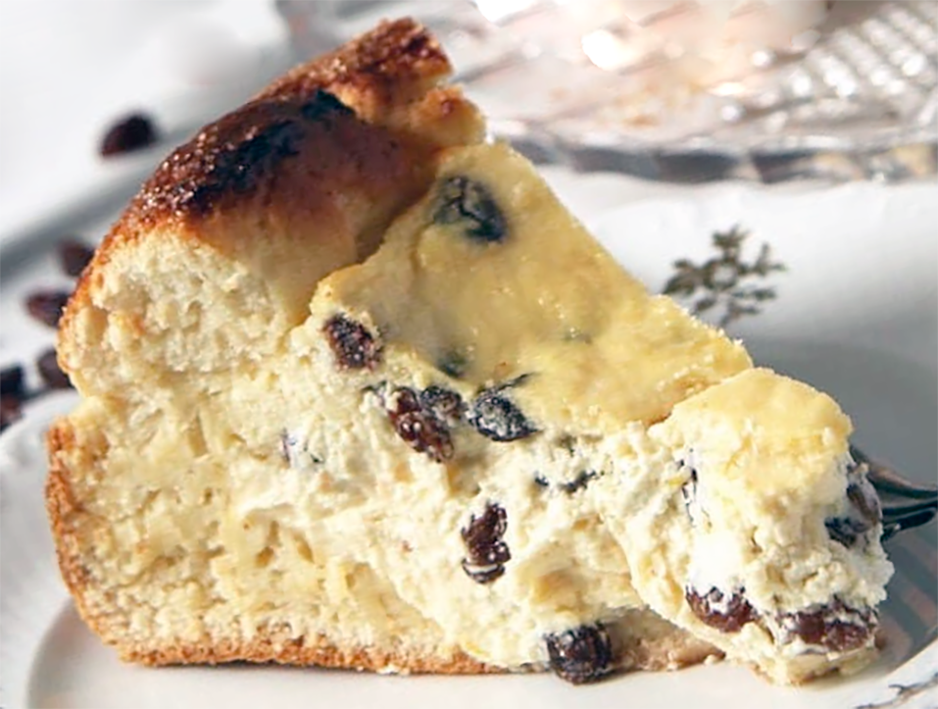
 Click on the image, above to submit to Pinterest.
Click on the image, above to submit to Pinterest.
Pasca de Pasti (Romanian Easter Cheesecake)
Pasca de Pasti (Romanian Easter Cheesecake) is a traditional Romanian recipe for raisin cheesecake baked in a sweet bread dough crust that's traditionally served for Easter. The full recipe is presented here and I hope you enjoy this classic Romanian version of: Romanian Easter Cheesecake (Pasca de Pasti).
prep time
60 minutes
cook time
45 minutes
Total Time:
105 minutes
Additional Time:
(+proving)
Serves:
14
Rating: 
Tags : Bread RecipesCheese RecipesBaking RecipesCake RecipesRomania Recipes
This is a really interesting cheesecake from Romania, where the cheesecake filling is baked in a leavened dough shell. This is typically prepared for and served over Easter.
Ingredients:
For the Yeast dough:
1 vanilla pod
250ml (1 cup) milk (+more if needed)
1 sachet (7g) active dry yeast
500g (4 1/2 cups) plain (all-purpose) flour
120g (2/3 cup) granulated sugar
50g (1/4 cup) unsalted butter
50ml (1/5 cup) vegetable oil
2 egg yolks
finely-grated zest of 1 lemon
pinch of fine sea salt
For the Filling:
400g (2 cups) Romanian cow's cheese (or use low-fat quark/cottage cheese (use the
home-made quark cheese to make your own))
2 eggs
3 tbsp granulated sugar (or more to taste)
100g (1/2 cup) raisins
3 tbsp semolina
1 tsp vanilla extract
finely-grated zest of 1 lemon
1 small egg for brushing
sugar to sprinkle on top
Method:
Begin with the vanilla milk: Split the vanilla pod lengthways, then scrape out the seeds and sSet aside. Pour the milk into a saucepan, add the empty vanilla pod and bring to a boil. Take off the heat and set aside to cool until lukewarm.
For the dough: place the yeast in a small bowl. Add 2 tbsp of the flour, 1 tbsp of the sugar then mix to a paste with 3-4 tbsp of lukewarm milk. Cover with a kitchen towel and set aside to rise in a warm place for 10-15 minutes.
Sift the flour into the bowl of your stand mixer (or food processor). Mix together the remaining sugar and remaining milk in a jug then set aside. Stir with a dough hook until combined. Melt the butter in a pan or a microwave then mix in the oil. Set aside to cool until needed.
After 15 minutes add the yeast mixture to the flour along with the egg yolks, vanilla seeds and lemon zest. Mix briefly then, with the motor running gradually add in the milk until the ingredients come together as a dough. At this point you may need to add a few more tablespoons to obtain a softer dough.
Now add a salt, then, little by little, work in the butter and oil mixture. Only add the next splash of this when the previous lot has been completely incorporated.
Knead the resultant dough in your mixture for 10 minutes. The dough will be soft and tacky. Turn into a clean bowl, then knead briefly with oiled hands. Shape into a ball, cover with a kitchen towel and set aside to rise in a warm spot for about 60 minutes, or until doubled in volume.
After about 40 minutes, pre-heat your oven to 180°C (350°F). Butter a 26cm (10 in) diameter springform cake tin then line the base with baking paper and set aside.
For the filling: Beat the cheese with a hand blender until smooth then mix in the eggs, semolina, raisins, sugar, lemon zest and vanilla extract. Adjust the sweetness to your personal liking.
Oil your hands slightly then remove the dough from its bowl. Divide into two equal pieces. Form one half into a fat sausage and cut this sausage into three parts. Roll each one into a ball then shape into long, thin, strings about 40cm (15 in) long. Plait the strings together into a long braid.
To assemble the cheesecake, flatten the second piece of dough then use to line the base of the springform cake tin. Prick all over with a form to ensure the dough will not rise too much in the oven.
Take the plait and press this into the sides of the tin to form a nice rim. Now pour the filling inside.
Brush over the top of the plait with the whisked egg and sprinkle with a little sugar.
Transfer to your pre-heated oven and bake for 40-50 minutes, until the cheesecake has nicely risen and is golden brown.
Prop the door of the oven open with a tea towel then allow to cool over night. The following day, unmould the cheesecake and serve.

 Click on the image, above to submit to Pinterest.
Click on the image, above to submit to Pinterest.
